Japandi style, a blend of Japanese minimalism and Scandinavian functionality, has become one of the most popular interior design aesthetics in recent years.
This soothing, natural style creates peaceful and tranquil spaces that promote mindfulness and wellbeing.
The dining room is often considered the heart of the home – a place for gathering, connecting, and creating memories over meals.
Designing a Japandi style dining room allows you to set the tone for quality time with family and friends.
The thoughtful approach of Japandi creates a calming oasis, emphasizing simple beauty, natural elements, and clean lines.
Today let’s discuss how to blend Japanese and Scandinavian principles to craft a soothing, minimalist aesthetic.
✨Click to Get My 101 FREE Designer Room Ideas
What is Japandi Style?
Before diving into dining room ideas, let’s look at what defines the Japandi aesthetic.
Japandi combines two distinct styles – Japanese minimalism and Scandinavian functionality – to create simple, calm interiors.
Japanese minimalism derives from ancient Zen philosophies emphasizing simplicity, tranquility, and living with intention.
This is achieved by eliminating clutter and focusing on essential elements like natural materials, subtle colors, and clean lines.
Japanese style embraces imperfection and values asymmetric, organic shapes and forms.
Scandinavian design centers on functionality, practicality, and simplicity.
Scandinavian style utilizes a light, airy palette along with natural wood tones.
Furniture and decor have an artisanal, handcrafted look.
Scandinavian interiors seamlessly blend indoor and outdoor spaces.
Together, these two styles create Japandi – a soothing, casual aesthetic ideal for modern living.
Japandi dining rooms incorporate natural woods like oak or walnut, rattan and bamboo furnishings, concrete or stone surfaces, and neutral color palettes.
Comfort is emphasized with plush pillows and fabrics.
Plants and greenery help connect the indoors with nature.
The overall effect is minimalist yet warm and welcoming.
Now let’s look at how to bring Japandi style to your own dining space with color schemes and decor to create a relaxing ambiance.
Neutral Tones with Rattan Chairs

The first Japandi dining room idea features neutral walls and ceiling paired with natural rattan chairs for zen-like tranquility.
Cream walls and pale wood ceiling beams establish a soothing backdrop, while the woven rattan chairs add organic texture.
A round dining table keeps the space open and airy.
The light wood dining table complements the rattan and pairs nicely with the simple white tulip legs.
Place settings are kept minimal – white dishes allow the textures and tones to shine.
A wooden sideboard in matching finish provides sleek storage.
Floating shelves make an attractive display area for plants, books, or decorative pieces above.
The neutral color scheme is accented by snippets of green from the foliage, adding life without clutter.
For lighting, a modern black pendant makes a striking focal point above the table.
Additional wall sconces provide perfect illumination for dining and conversation.
This calming, neutral dining room with rattan chairs uses Japandi elements like wood, rattan, and greenery to create a relaxed aesthetic.
Light and Airy with a Concrete Dining Table
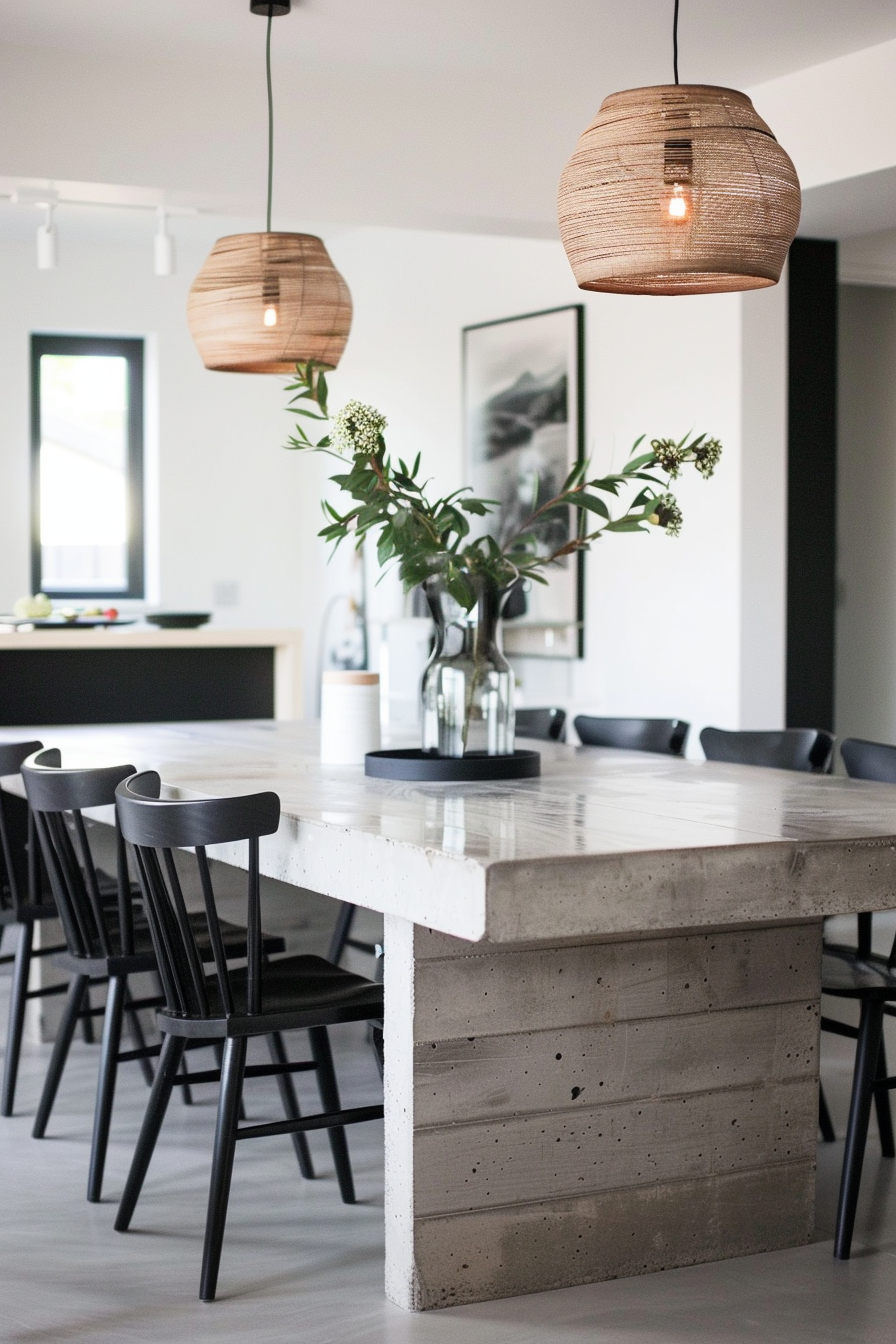
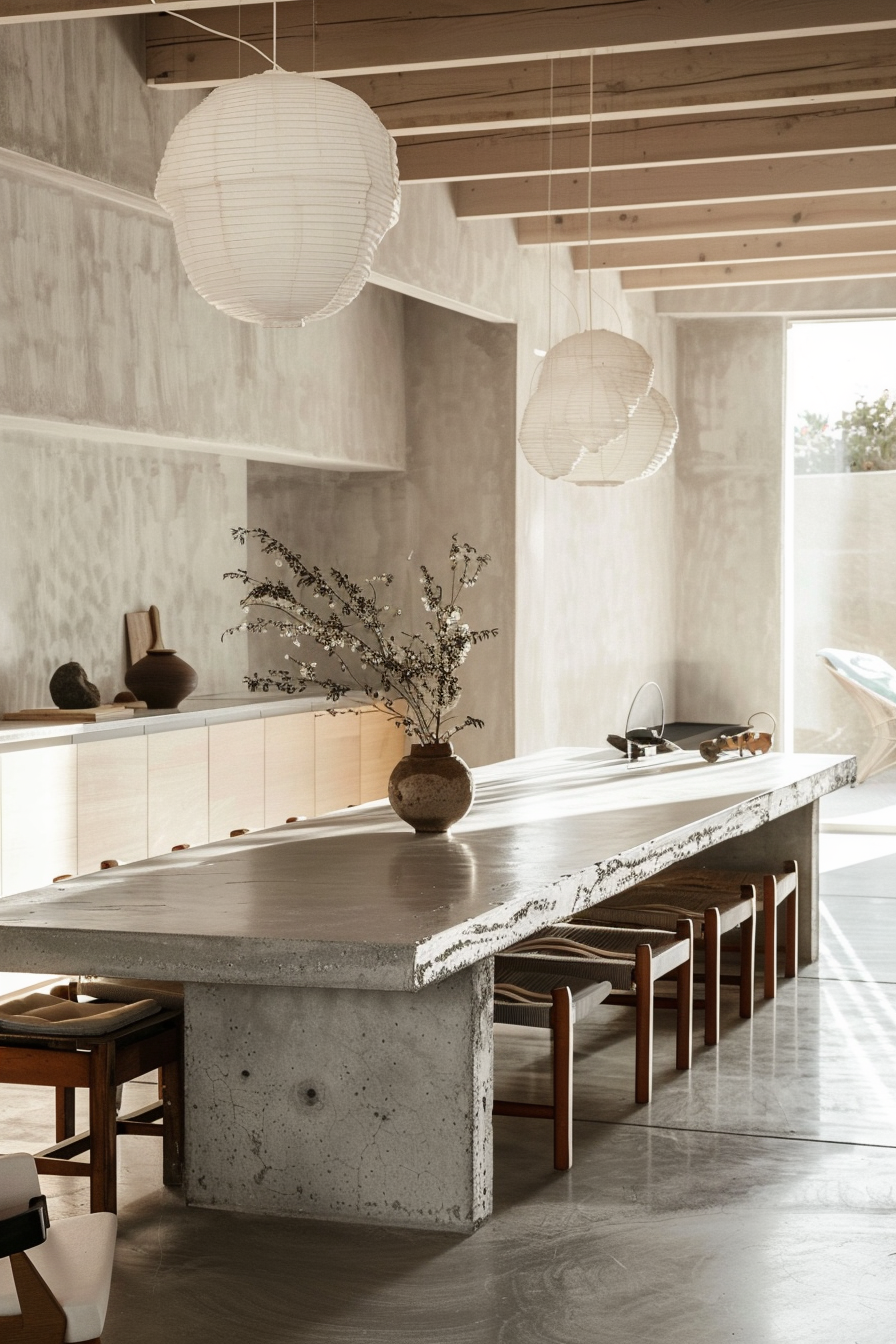
The next Japandi dining room uses a light, neutral color palette paired with a raw concrete dining table for an airy, minimalist look.
The concrete dining table makes a sculptural statement with its organic shape and naturally varied gray tones.
Crisp white walls, ceiling beams, and trim keep the background fresh and bright.
The golden pine wood floor grounds the space with warmth.
Matching mid-century style chairs complement the concrete tabletop in a sleek blond wood.
To incorporate greenery, miniature potted succulents are arranged down the center of the table for a unique living centerpiece.
The mix of materials from natural concrete to the soft green plants creates a soothing balance.
A large rattan pendant light hangs above the concrete table, reinforcing the calming, natural aesthetic.
The airy, all-white builtin cabinet and open shelves provide discreet storage solutions without clutter.
This dining room uses Japandi’s light and neutral palette to open up the space, while raw materials add organic texture.
Rustic Minimalism with Exposed Beams
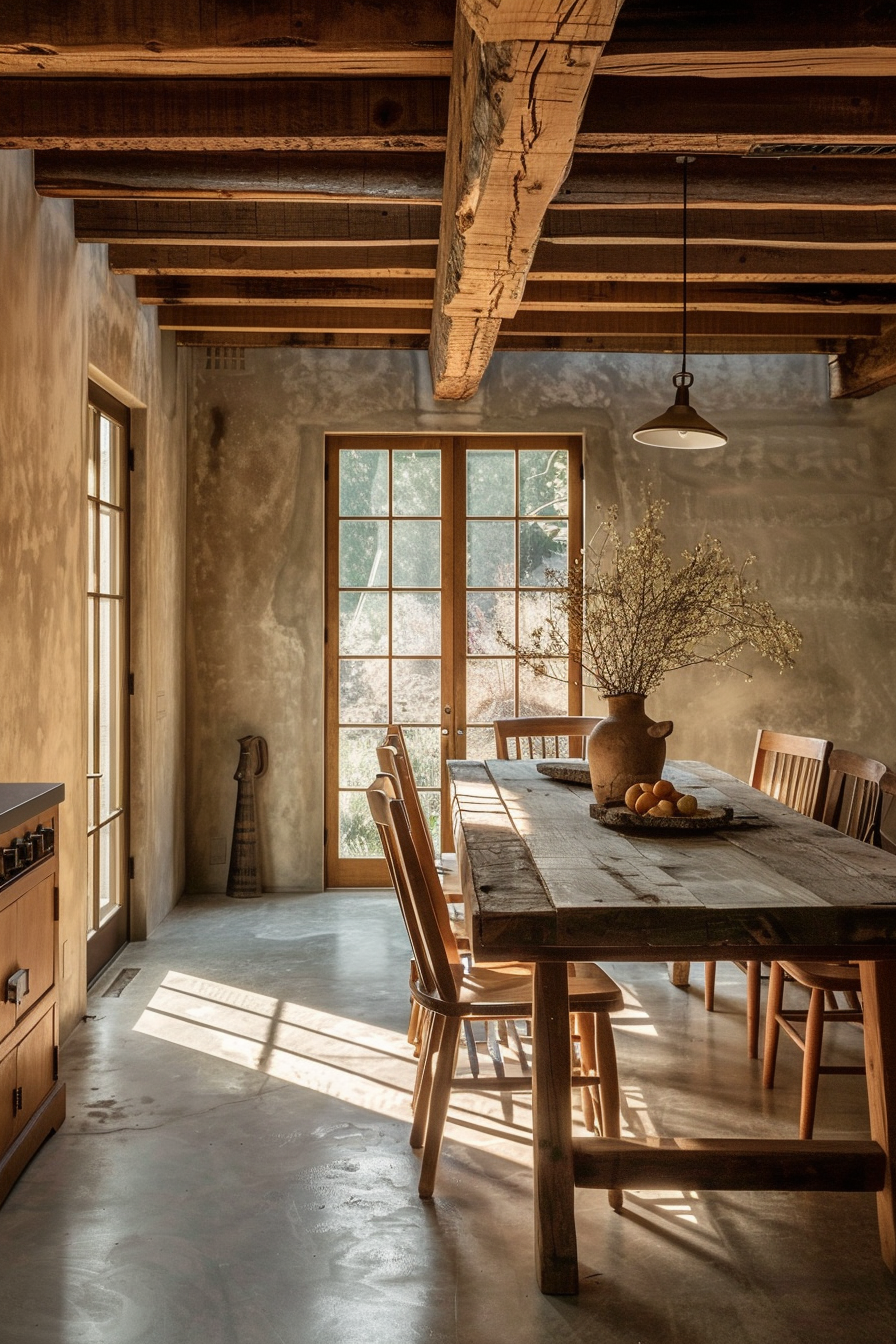
Achieving a minimalist Japandi dining room with rustic elements is possible by exposing the ceiling beams.
This dining room uses bare wooden beams across the white shiplap ceiling to add natural texture and warmth.
Exposed beams interplay with crisp white wainscoting on the walls for contrast.
The beams work beautifully with the reclaimed wood dining table, which has a raw, organic shape punctuated by metal hairpin legs.
Matching wooden chairs have airy, rounded backs that complement the table’s modern base.
A woven rattan pendant light reinforces the calming, natural style.
The unfinished look of the exposed beams, reclaimed table, and rattan light balance the clean white walls in this farmhouse Japandi dining room.
✨Click to Get My 101 FREE Designer Room Ideas
Modern Industrial with Black and Wood
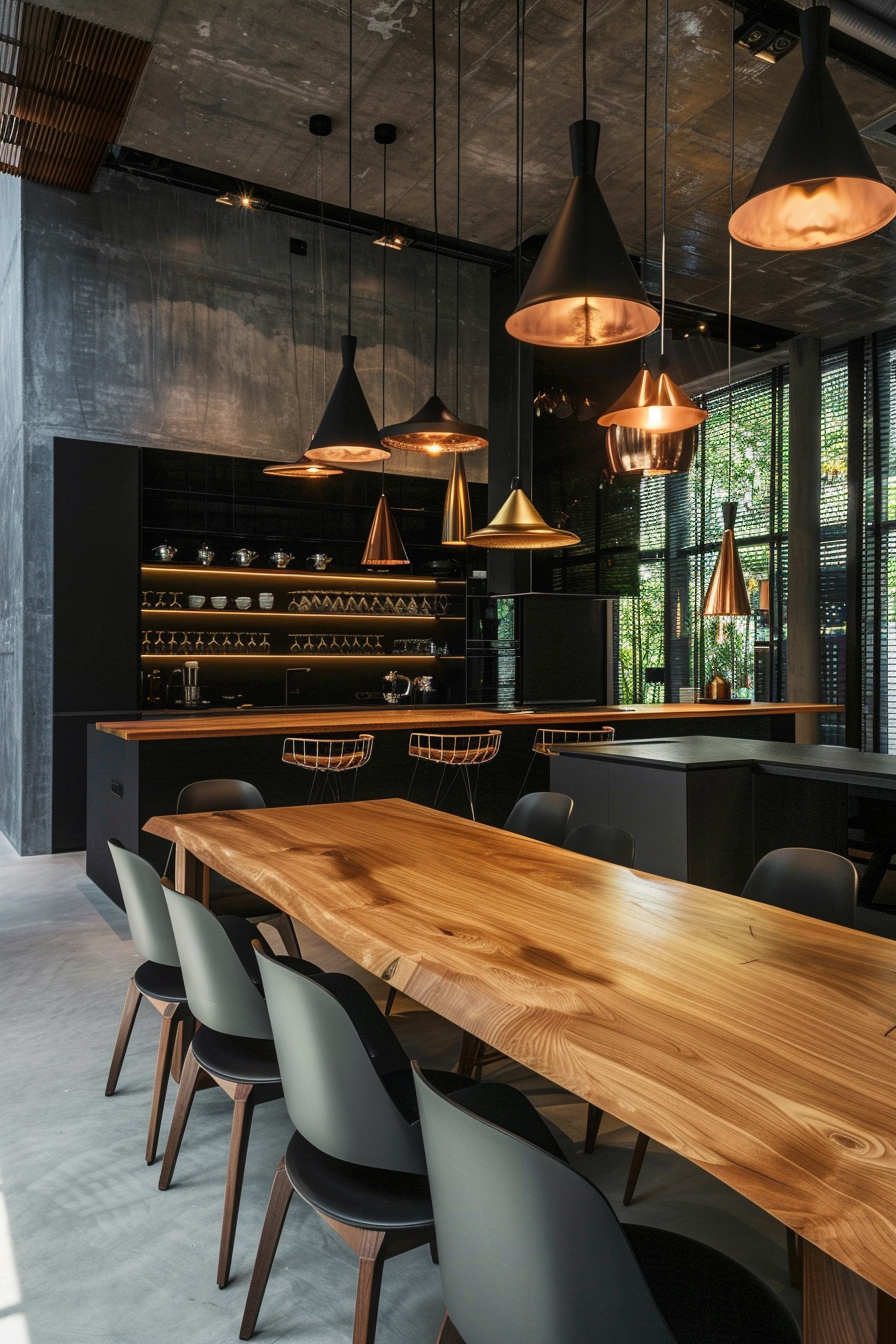
The industrial trend can be fused seamlessly with Japandi style for a modern dining room.
The blend of black and natural wood evokes Japanese design principles.
Bold black walls make a dramatic statement and backdrop for the wooden furnishings.
The plank wood dining table with black legs continues the modern mood.
Matching black dining chairs keep the look cohesive.
Industrial-style cage pendant lights add eye-catching metallic elements.
To balance the dark walls, the rustic wood floor and open shelf display provide a warm natural contrast.
The shelves display ceramic dinnerware, greenery, and accent lighting for visual interest.
This modern black and wood palette creates an inviting, dynamic Japandi dining room.
Warm Wood Elements with Brick Accent Wall
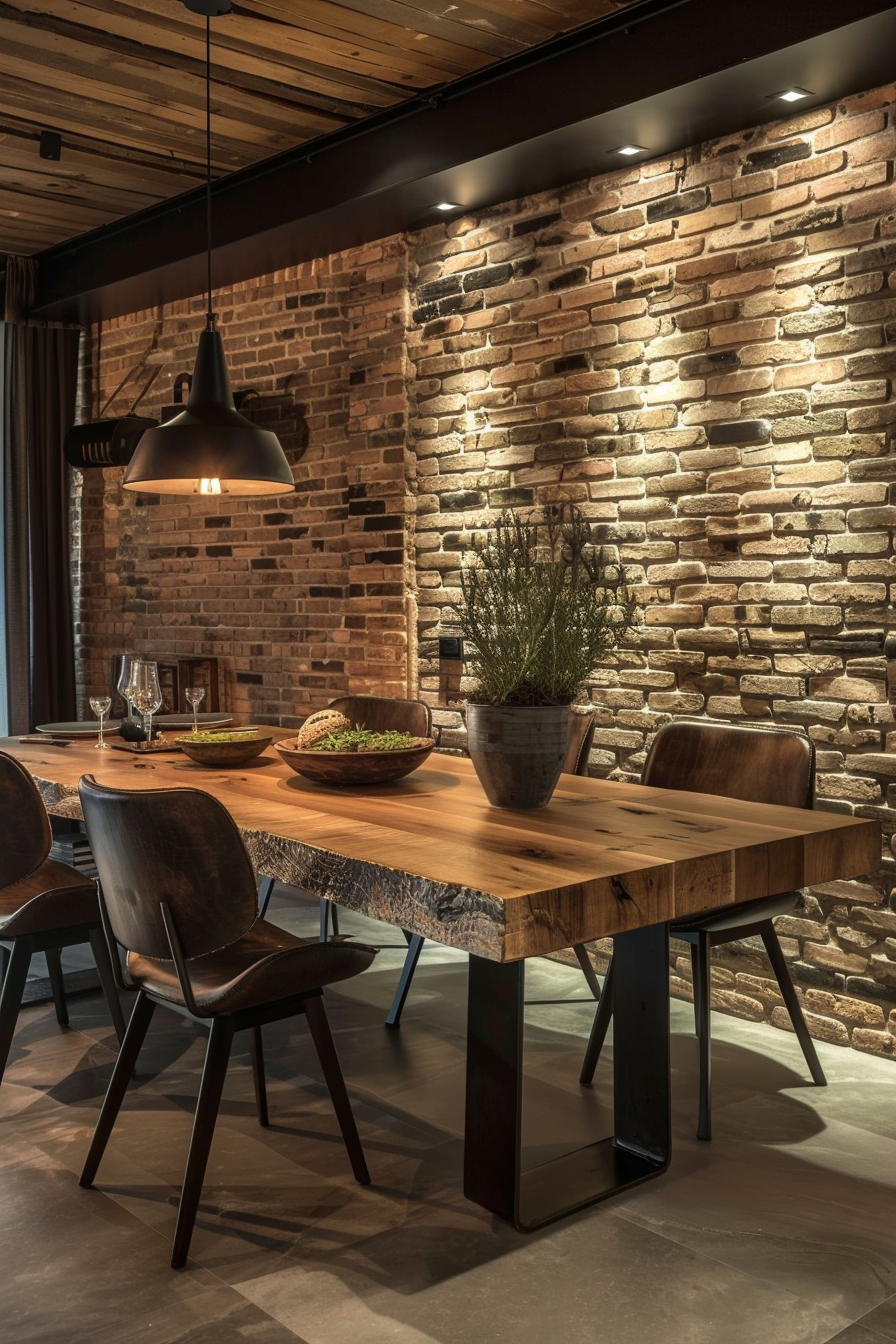
Warm wood furnishings paired with a brick accent wall give this dining room rich, organic texture.
The reclaimed wood dining table has a plank-style surface and stylishly mismatched legs for character.
Complementing crossback chairs feature intricate wood details.
One wall is clad in exposed brick with varying earth tones, giving the space a casual, rustic vibe.
The remaining walls and ceiling are painted crisp white to keep the room feeling bright and airy.
Floating open shelves provide a place to display potted greenery, creating a living accent wall.
The mix of materials – weathered wood, worn brick, and leafy plants – results in a welcoming Japandi dining room with depth and dimension.
A black drum pendant light anchors the space with contrast.
This is a great example of blending natural elements like wood, plants, and earthy brick to craft a grounded, organic Japandi style.
Nature-Inspired With Faux Rattan Chandelier
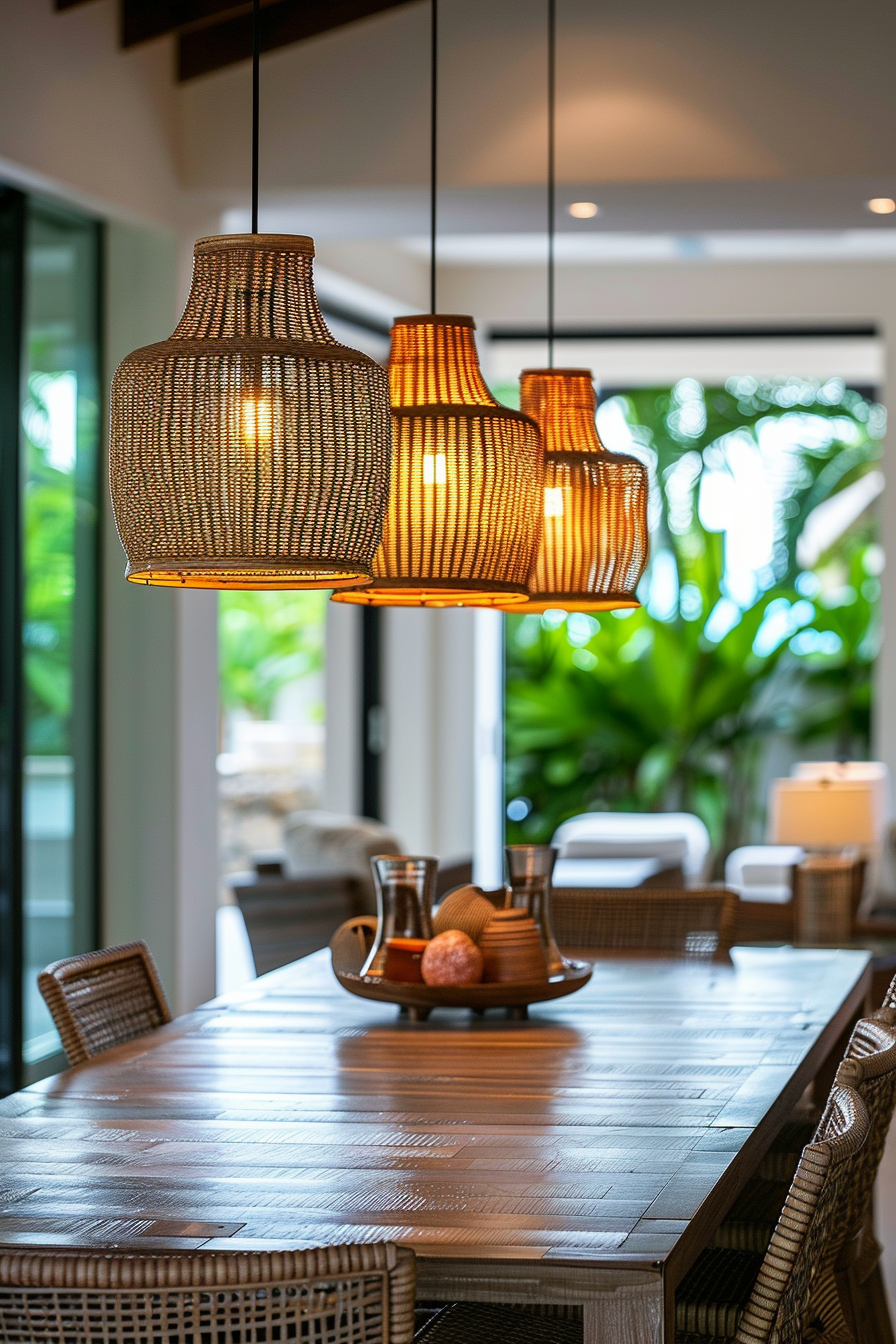
Bringing nature indoors is central to Japandi design.
This dining room uses faux rattan and greenery to craft a nature-inspired aesthetic.
A remarkable chandelier with dangling rattan orbs and leadership creates a sunburst focal point.
The lightweight rattan makes a bold statement without overwhelming the space.
Crisp white walls, trim, and ceiling beams frame the space in brightness.
The oval dining table and curved chairs continue the room’s oval motif.
A large floor plant in the corner reinforces the nature theme and adds life.
The key to this look is blending ultra-modern elements like the statement chandelier with natural materials like rattan and foliage.
The result is a vivid dining room balanced in Japandi tranquility.
Crisp Black and White Minimalism

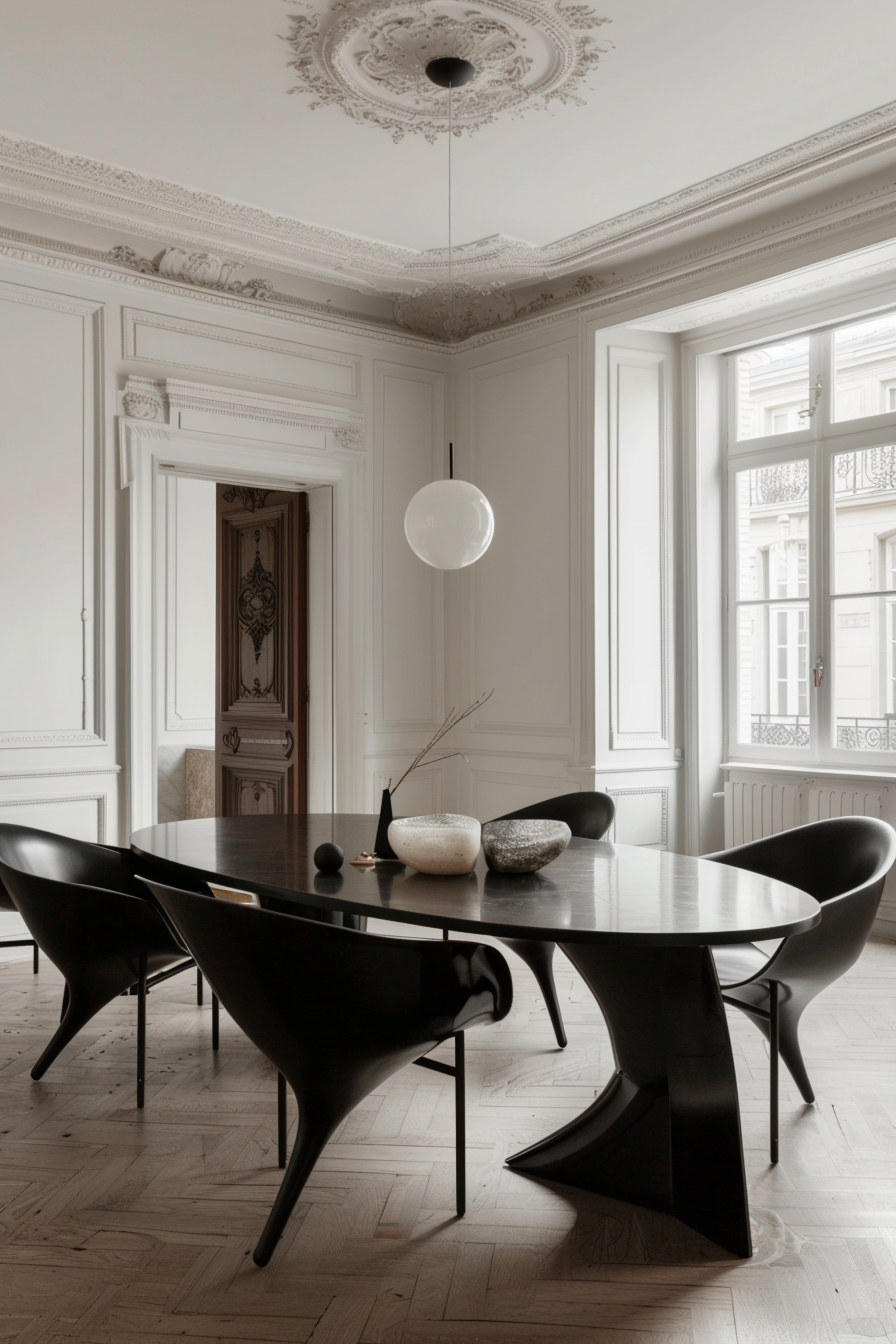
For a super-sleek Japandi dining room, a crisp black and white palette hits the minimalist aesthetic.
The black dining chairs and table contrast dramatically with clean white walls, wainscoting, and built-in cabinetry.
This bold yet simple color scheme creates a soothing, zen space.
To incorporate natural elements, a large black and white abstract painting depicts swirling branches.
A spiky fiddle leaf fig plant beside the cabinet adds a fresh pop of green.
Woven placemats on the dining table tie in texture.
For lighting, adjustable spotlights provide directional illumination to highlight the dining table and decorative accents.
The absence of clutter paired with the bold color scheme results in a sharply modern, gallery-like Japandi dining room.
✨Click to Get My 101 FREE Designer Room Ideas
Casual Eclectic with Woven Textures

Japandi also translates beautifully into casual, eclectic spaces.
This dining room blends woven natural fiber furnishings with modern elements for visual interest.
A jute area rug with a geometric border pattern defines the space.
The oval dining table features an easy-to-clean laminate wood top and crosswoven seagrass base for unique texture.
Mismatched woven rattan chairs complement the table’s casual aesthetic.
Bold print drapes add softness and filter incoming daylight.
Floating shelves built from distressed wood display collected treasures, books, and greenery above a comfy rattan bench.
The mix of unfinished woods, fibers, prints, and plants gives this dining space a collected, inviting vibe with lots of tactile appeal.
The casual eclectic look still aligns with Japandi principles by keeping the space relaxed, natural, and functionally designed.
Modern Japandi with Dark Teal Built-Ins
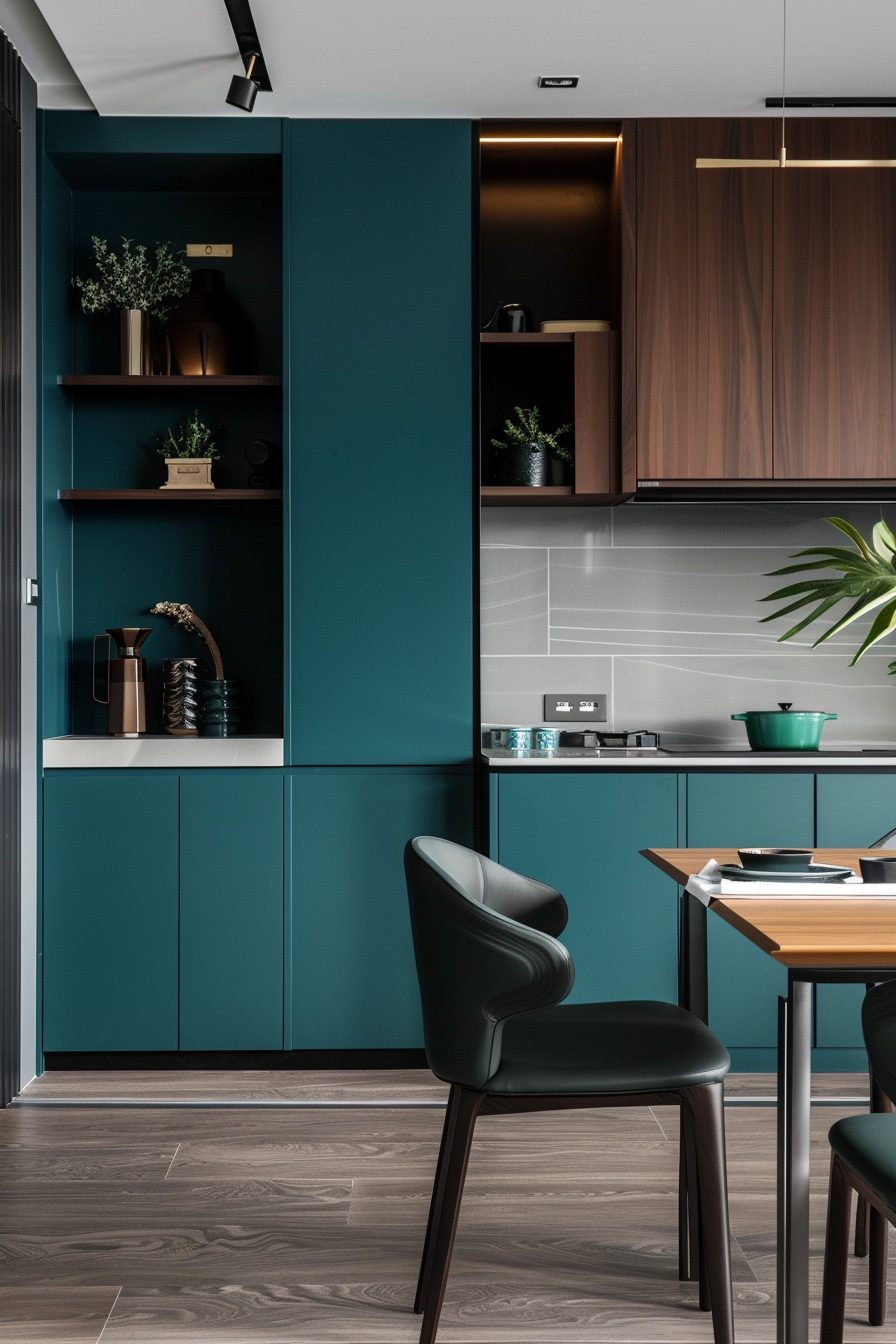
Deep, moody hues can be incorporated into Japandi dining rooms to create modern drama.
Here, the dining space features custom cabinetry painted in rich teal.
The dark color choice makes the built-in a focal point and pops against bright white walls.
Sleek furnishings complement the colorful built-ins, including a glass and metal dining table and velvet chairs in navy – echoing the teal accent wall.
Industrial metal pendants add eye-catching light fixtures.
Simplicity is maintained through the absence of clutter and decor.
The dark drama of the teal built-in cabinetry balances lightweight glass and metal furnishings in this bold modern dining room.
Keeping decoration minimal allows the colors and textures to take center stage for a stunning look.
Earthy Tones and Organic Shapes

Japandi spaces celebrate raw, unfinished looks with asymmetric, organic shapes.
This dining area leans into earthy tones and shapes for a grounded, natural aesthetic.
The rough-hewn elm dining table has an uneven edge and organic form that contrasts beautifully with the straight lines of the built-in cabinetry.
The dining chairs feature curved oak frames and rattan seats in a tobacco stain.
The neutral color palette is continued with linen roman shades, jute rug, and open shelving made from slab elm wood.
Touches of black metal provide contrast, including the dining chair legs and pendant light.
Overall, the raw unfinished look creates a rustic yet refined Japandi dining room.
Minimalist With Glass Pendant Light
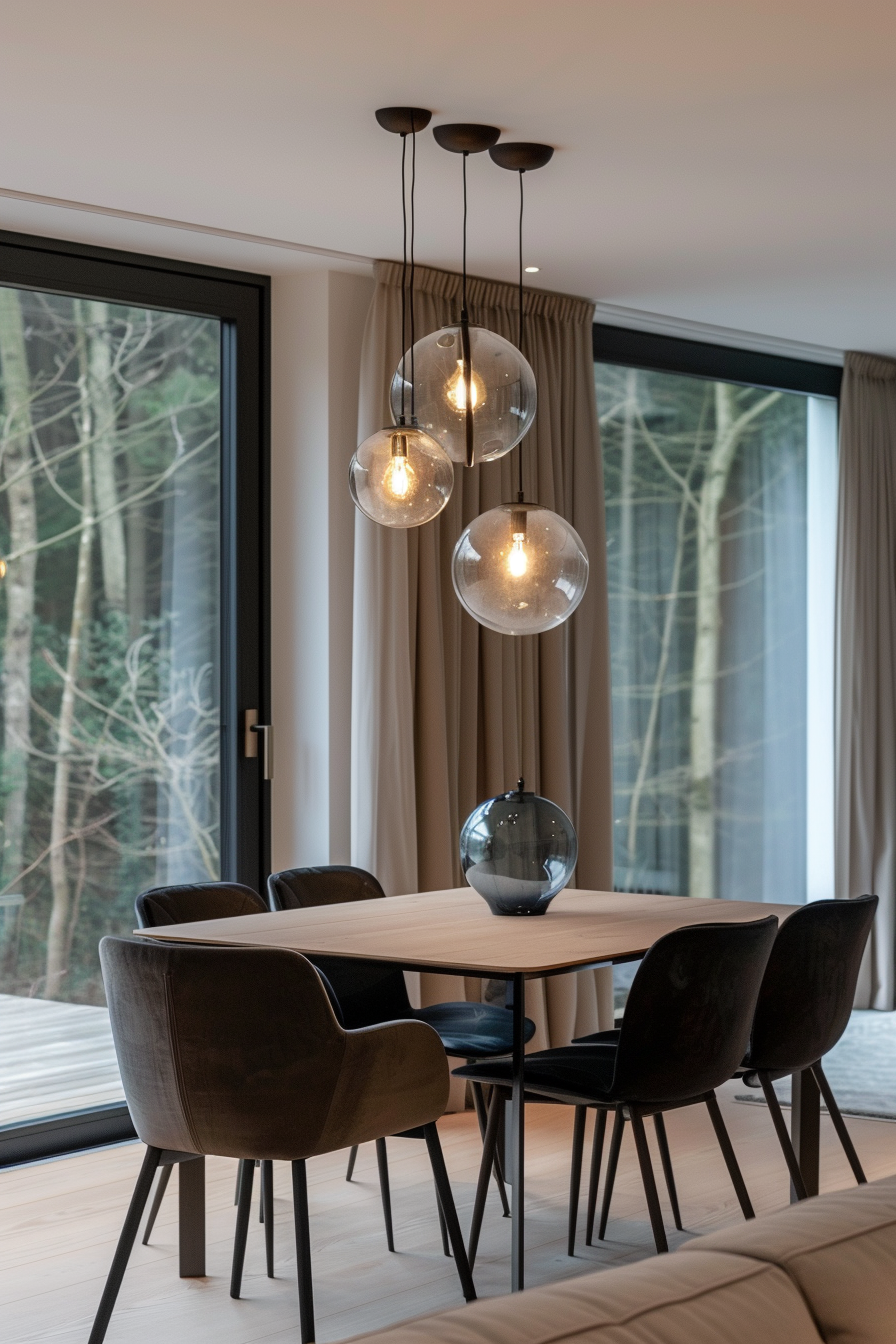
This bright, airy dining room embodies Japandi principles through minimalist, natural materials.
At the center, a round glass and metal pendant light mimics the shape of the table.
The see-through glass fixture allows light to filter through for a soft ambient glow.
A simple parsons style dining table and chairs keep the look unfussy.
Neutral linen upholstery adds softness on the chairs.
The light wood dining set pairs perfectly with the bamboo flooring.
Crisp white cabinetry blended with open shelving keeps the space looking airy but functional.
The glass light and absence of clutter embody Japandi minimalism – the perfect backdrop for quality time.
✨Click to Get My 101 FREE Designer Room Ideas
Modern Concrete With Pops of Blue
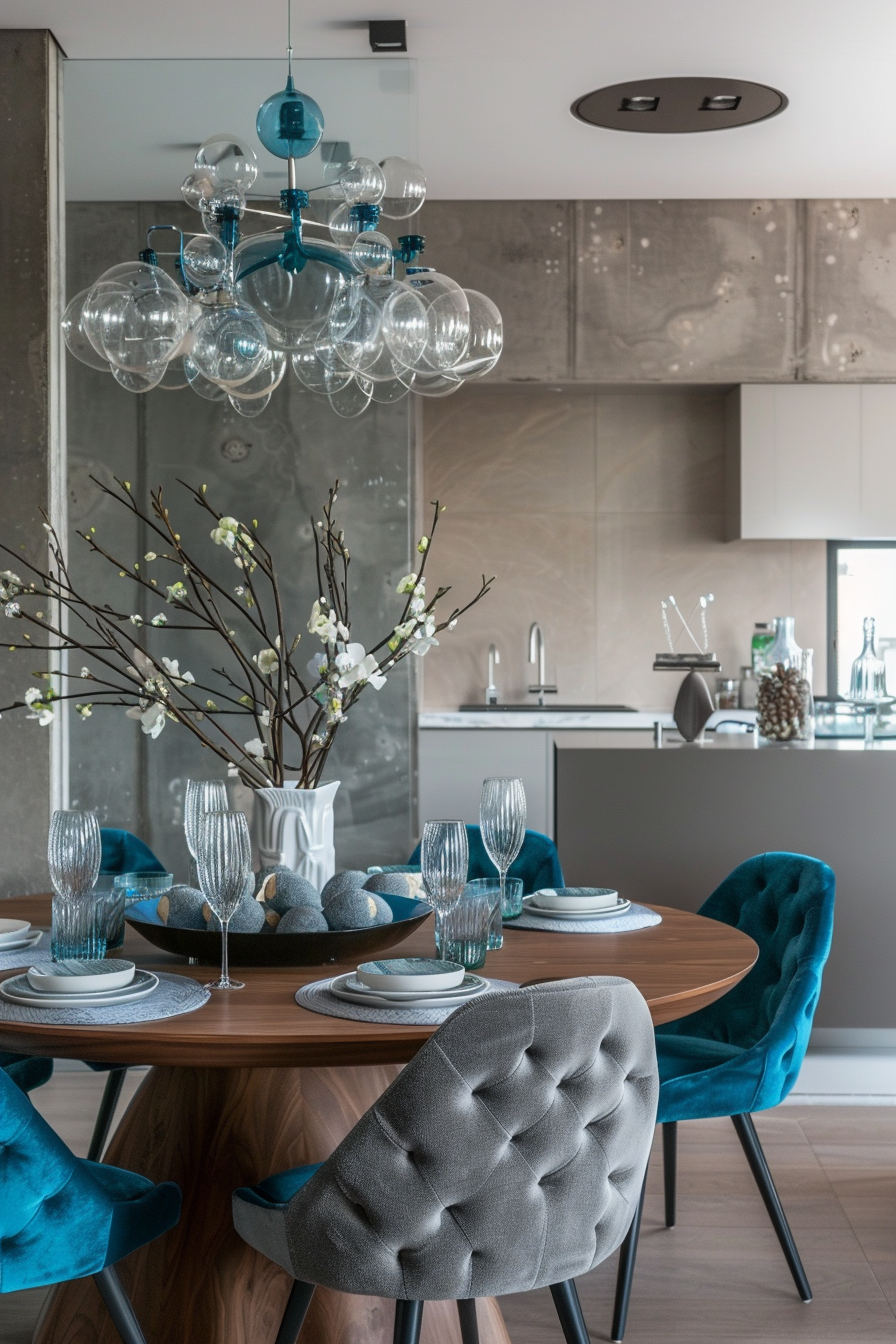

Japandi interiors can also take bolder, more contemporary directions while still feeling balanced and tranquil.
Here, a raw concrete dining table adds organic texture.
The irregular surface introduces natural variation and interest.
Glossy cherry red chairs pop against the concrete table and provide the focal color accent.
Navy blue drapes filtering in light balance out the bright red.
The body of the space stays neutral with cream walls, blonde wood flooring, and a jute area rug.
Pops of green from a bonsai tree and eucalyptus in a vase inject liveliness.
The bold colors are woven seamlessly into the pared-back Japandi aesthetic for a modern, stylish look.
Natural Wood Elements and Macrame

This last dining room highlights the inherent beauty of natural wood elements.
The plank wood dining table and bench seating have a raw, organic shape and finish.
Matching woven macrame pendants reinforce the natural theme.
One accent wall is clad in vertical wood planks with visible gaps for breathability.
The unfinished wooden wall adds gorgeous texture and complements the dining set.
A macrame owl wall hanging adds a whimsical touch while sticking to the nature-inspired style.
The windows are left undressed to emphasize simplicity and let natural light filter into the space.
Overall, this dining room feels laidback and tranquil with its wood elements and airy light.
Japandi dining rooms exemplify peace, simplicity, and functional design.
By blending Japanese minimalism with Scandinavian practicality, Japandi spaces are the perfect antidote to our increasingly busy and cluttered lives.
As you design your Japandi dining area, focus on natural unfinished woods, stone and concrete elements, rattan and woven accents, and plants for an organic feel.
Neutral, earthy color palettes help evoke tranquility.
Minimalist, asymmetric furnishings and decor align with Japandi principles.
Use this article as inspiration to craft your own soothing Japandi dining sanctuary.
Focus on how the space makes you feel rather than perfection.
The Japandi aesthetic values imperfections and celebrates raw, organic beauty.
Your dining room is so much more than just a place to eat.
Designing this space with intention using Japandi elements creates an inviting, calming environment for meaningful connections.
Gathering around the table is a ritual – infuse that ritual with peace and tranquility by applying Japandi style.

